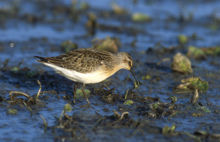- Curlew Sandpiper
-
Curlew Sandpiper 
Juvenile. Conservation status Scientific classification Kingdom: Animalia Phylum: Chordata Class: Aves Order: Charadriiformes Family: Scolopacidae Genus: Calidris Species: C. ferruginea Binomial name Calidris ferruginea
(Pontoppidan, 1763)Synonyms Erolia ferruginea Vieillot, 1816
The Curlew Sandpiper (Calidris ferruginea) is a small wader that breeds on the tundra of Arctic Siberia. It is strongly migratory, wintering mainly in Africa, but also in south and southeast Asia and in Australasia. It is a vagrant to North America.
Contents
Description
These birds are small waders, only slightly larger than Dunlin at 19.5–21 cm in length, but differ from Dunlin in having a longer down-curved bill, longer neck and legs and a white rump. The breeding adult has patterned dark grey upperparts and brick-red underparts. In winter, this bird is pale grey above and white below, and shows an obvious white supercilium. Juveniles have a grey and brown back, a white belly and a peach-coloured breast.
Behaviour
The male Curlew Sandpiper performs an aerial display during courtship. The clutch of 3–4 eggs are laid in ground scrape in the tundra.
This wader is highly gregarious, and will form flocks with other calidrid waders, particularly Dunlin. Despite its easterly breeding range, this species is regular on passage in western Europe, presumably because of the southwesterly migration route.
It forages in soft mud on marshes and the coast, mainly picking up food by sight. It mostly eats insects and other small invertebrates.
The numbers of this species (and of Little Stint) depend on the population of lemmings. In poor lemming years, predatory species such as skuas and Snowy Owls will take Arctic-breeding waders instead.
This species occasionally hybridizes with the Sharp-tailed Sandpiper and the Pectoral Sandpiper, producing the presumed "species" called "Cooper's Sandpiper" ("Calidris" × cooperi) and "Cox's Sandpiper" ("Calidris" × paramelanotos), respectively.
Taxonomy
This is a fairly unusual species, and has been proposed as type species of the genus Erolia but the DNA sequence data is currently insufficient to resolve its relationships (Thomas et al., 2004). This matter is of taxonomic relevance since, as the Curlew Sandpiper is the type species, a close relationship with the small "stint" sandpipers would preclude the use of Erolia for the present species.
The Curlew Sandpiper is one of the species to which the Agreement on the Conservation of African-Eurasian Migratory Waterbirds (AEWA) applies.
With Red-necked Stint, Manly Marina, SE Queensland, Australia
References
- ^ BirdLife International (2004). Calidris ferruginea. 2006. IUCN Red List of Threatened Species. IUCN 2006. www.iucnredlist.org. Retrieved on 09 May 2006. Database entry includes justification for why this species is of least concern
- Hayman, Marchant and Prater, Shorebirds ISBN 0-873403-19-4
- Mullarney, Svensson, Zetterstrom and Grant, Collins Bird Guide ISBN 0-00-219728-6
- Thomas, Gavin H.; Wills, Matthew A. & Székely, Tamás (2004): A supertree approach to shorebird phylogeny. BMC Evol. Biol. 4: 28. doi:10.1186/1471-2148-4-28 PDF fulltext Supplementary Material
External links
Categories:- IUCN Red List least concern species
- Calidris
- Erolia
- Sandpipers
- Birds of Europe
- Birds of Turkey
- Birds of Africa
- Birds of Asia
- Birds of Pakistan
- Birds of South Australia
- Birds of Tasmania
- Birds of Western Australia
- Birds of Azerbaijan
Wikimedia Foundation. 2010.

